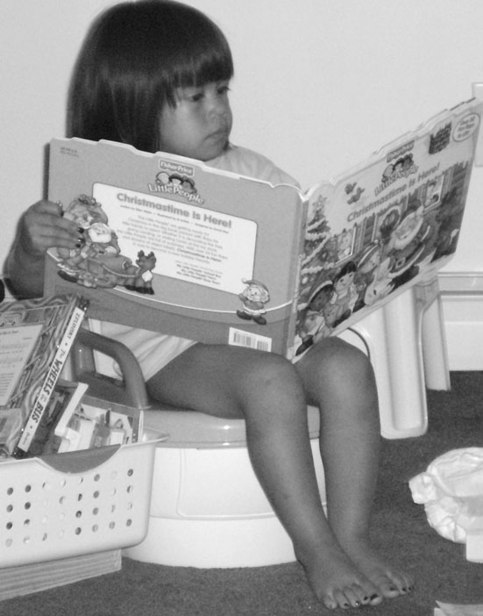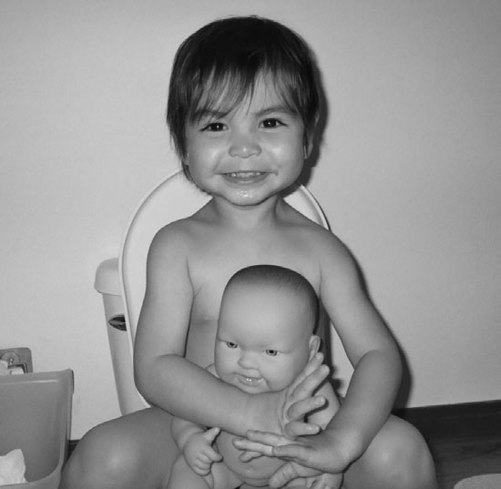The No-cry Potty Training Solution (12 page)
Read The No-cry Potty Training Solution Online
Authors: Elizabeth Pantley


A Menu of Potty Training Ideas
77
Mother-Speak
“Anna does what we call the potty dance. She wiggles and shimmies while holding her crotch and shifting from foot to foot. It’s entirely obvious that she has to go, but when you ask her if she has to use the bathroom, she always says no!”
—Julie, mother of three-year-old Anna
before getting in the car, and before bed. In addition, watch your toddler closely, and anytime you think a visit to the potty might be timely, go ahead and take her.
Don’t ask, “Do you have to go potty?” because the answer from a busy toddler will almost always be no (yet another case in which asking a yes-or-no question of a toddler is ill advised). Instead, make a positive suggestion, such as, “Let’s go sit on the potty now.” Positive works better than negative here—much better than saying, “Don’t wait so long that you pee in your pants!”
(Then she probably will.)
Offer Choices
Another way to encourage your child to use the potty is to offer interesting choices. Children love to be given choices and often will cooperate just because you’ve given them the freedom to choose. Here are a few great potty choices:
78
The No-Cry Potty Training Solution
“Do you want to use the upstairs potty or the
downstairs potty?”
“Do you want to walk to the potty or run to the potty?”
“Do you want to use the big toilet or your potty chair?”
“Shall we use the potty before snack or after
snack?”
“What do you want to do first, get dressed or use the potty?”
“Do you want Mommy to come with you, or do you
want to go all by yourself?”
Make It a Game
Why would your child want to interrupt his fun activities every two hours if going to the potty is a boring chore? If you can liven things up a bit, your child will be a more willing participant.
You might introduce a fun ritual for getting to the bathroom. For example, call it the potty train.
Announce its arrival with a loud “Choo! Choo!,” and call “All aboard!” to your child, encouraging him to follow you. Chug around the room a bit and end up at the Potty Stop. If the train comes every few hours, and if it’s a happy train, your child should willingly follow.
After a time, if the train loses its appeal, you can switch to an airplane and fly to the bathroom or become a circus parade or lions on the prowl or any other current imaginary favorite.
A Menu of Potty Training Ideas
79
A variation on this game idea is to have a race to the bathroom. (Careful, though. Don’t race if your child’s been doing the potty dance—this might cause an accident!) You could also be spaceships and count down to launch time, or take advantage of your child’s current favorite animal or cartoon character to create a fantasy journey to the bathroom.
Yes, you might find this all a little boring, and the choo-chooing and parading might be the last thing you feel like doing. But compared to begging an uninterested child to please,
please
sit on the potty, it’s so much more effective!
Come with Me!
Most young children love to be with Mommy or Daddy no matter where you go, and they will happily join you in the bathroom when you have to go. If you’ve always been open about having your child in the bathroom with you, invite him to come with you when you go, and then suggest that he sit on his potty while you sit on yours. The two of you can talk or sing together while you sit side by side.
In some families, privacy is more closely guarded, and children don’t accompany their parents into the bathroom or share the room when a parent is dressing. If this has been the way things work in your home, it’s best not to change your behavior now. There’s no rule that says you must demonstrate toileting, and your child will learn how to use the potty even if he never sees you go.
80
The No-Cry Potty Training Solution
Read About the Potty
There are lots and lots of books for children about potty training, because it is a popular toddler topic. But be forewarned! Many of them may be fun and entertaining for your child but aren’t at all helpful when it comes to potty training. Some are vague and use words that don’t match your own vocabulary. Some use pictures of potty chairs that don’t look anything like real potty chairs. Some of these children’s books are quite silly, and some demonstrate things you don’t want your child to try, like wearing his potty on his head, turning his seat upside down, storing toys in the potty, or unrolling the whole roll of toilet paper. He may never have thought of these grand ideas until the book came along!
I strongly suggest that you read any children’s potty books yourself before you read them to your child to make sure that they mesh with your potty training agenda. A list of suggested titles is on the next page.
Make a Custom Potty Book
The most perfect potty book is one about your very own child! You can create a personalized toilet training book for your child that will reinforce what you are teaching.
It will likely become your child’s favorite book.
Simply take photos of your child at every step of the potty process. The first photo should be of your child playing with toys, so you can explain that he must first identify the urge and stop what he’s doing. The second will show your child’s trip down the hallway, and the third is your child entering the bathroom. This

A Menu of Potty Training Ideas
81
Suggested Reading for Your Little
Potty Learner
My Big Girl Potty and My Big Boy Potty
by Joanna Cole, illustrated by Maxie Chambliss
HarperCollins, 2000
Potty Time! (Toddlers) (Learning Ladders)
by Betty Reichmeier
Random House Books for Young Readers; Yellow edition, 1988
First Experiences: It’s Potty Time
by Roger Priddy
Priddy Books, 2004
Wash Your Hands!
by Tony Ross
Kane/Miller Book Publishers, 2000
sequence of photos will continue right up to the final hand washing and drying and leaving the bathroom afterward with a look of pride. Yes, a picture of poop and pee-pee in the potty will make a gleeful addition to your homemade book! And happy Mommy and Daddy faces
are a great ending.
Glue these pictures onto pages made of strong paper or poster board, and tape them together in book format using strong packing tape. Narrate the action using sim-82
The No-Cry Potty Training Solution
ple sentences. Read this book to your child either prior to potty runs or while he is sitting on the potty.
Making the book an interactive adventure will give it even more value. Simply leave empty spaces on each page or place a handful of blank pages at the end. Allow your child to add a sticker or draw a happy face into his book after each successful bathroom visit.
I guarantee that your child will enjoy having his own special book, and very likely it will help him enjoy the process. It will be a great way to help your child remember all the steps involved.
Potty Time Book Reading
Reading to a child while she’s on the toilet is a common practice. There are two very good reasons for this.
First, young children don’t often sit still in one place for very long unless something is holding their attention. Because most children love to read or be read to, this is a great incentive for them to sit patiently.
Second, in order for a child to pee or poop, his sphincter muscles must relax. When a child doesn’t want to sit and he’s anxious to get back up, these muscles tighten up and elimination is nearly impossible.
Listening to a story causes a child to be attentive to you, and his body relaxes. If his bladder or bowel is full, he’ll be able to naturally release and go potty.
Should you read books about potty training? Maybe.
Some children enjoy the stories that relate to what they are doing at the moment. Others find that it puts too much emphasis on the process or that it creates performance anxiety. How do you know which to read? Hold up two books and let your child choose.

A Menu of Potty Training Ideas
83
Sage, three years old
Tell Stories, Chitchat, and Sing
In the same way that reading books encourages a child to sit still and relax, telling your child a story, talking about the day, or singing a song brings the same results.
Because your child is likely hungry for your one-on-one 84
The No-Cry Potty Training Solution
attention (they all are!), this works like a charm. It’s also a great way to take advantage of the time you must spend together in the bathroom. If you’re going to be there, you may as well relax and enjoy it!
If you have a younger toddler or baby in the house, set up a toy area in the bathroom for your other child.
Rotate the toys so that they are always interesting. If you have a baby who’s nursing, bring in a chair and nurse the baby while your toddler is doing his potty business. These ideas make bathroom visits enjoyable for everyone.
Make a Potty Poster
There’s a lot to learn when a child is just starting out with potty training. You can help your child remember the details of what to do by making her a potty poster.
As with the custom potty book mentioned earlier, take potty-process photos of your child, or cut pictures from magazines. Glue these pictures in sequence on a large piece of poster board or cardboard. Number the action from start to finish. Hang your creation at your child’s eye level in the bathroom, perhaps on the bathroom door.
When you are guiding your child to do a practice run, ask her to help you read the poster and follow the actions herself. Ask her, “OK, now what comes next?”
And respond with, “Good for you!” when she knows what to do.
You can make the poster even more special by allowing your child to add a sticker to her poster each time

A Menu of Potty Training Ideas
85
Christian, three years old
she uses the potty. You can either create a blank space for stickers or just let her put them wherever she wants.
